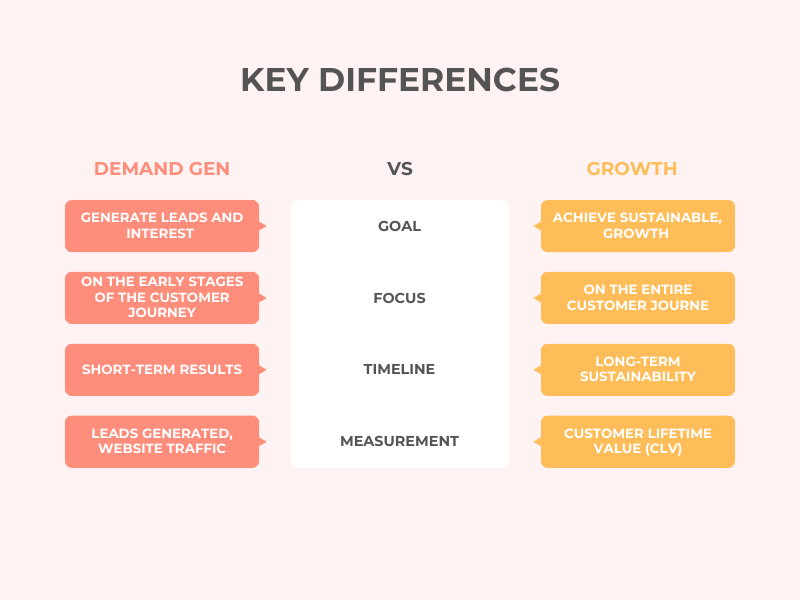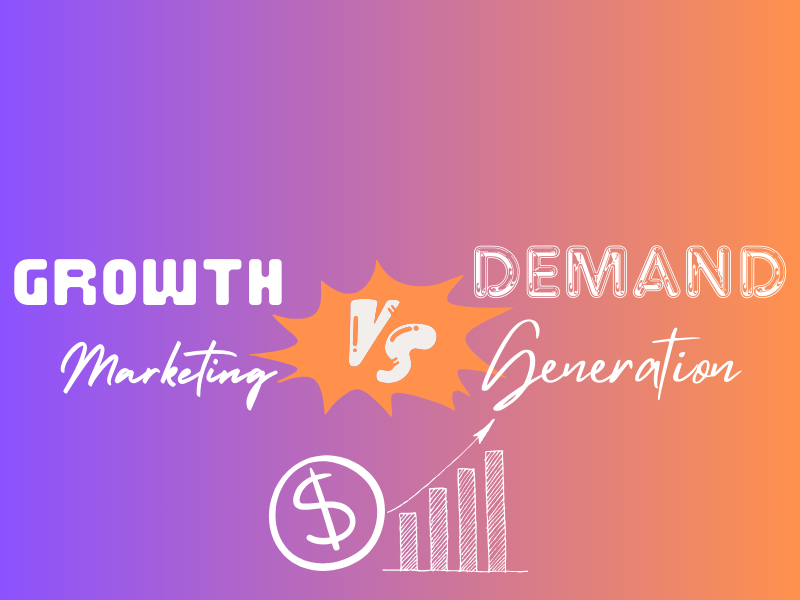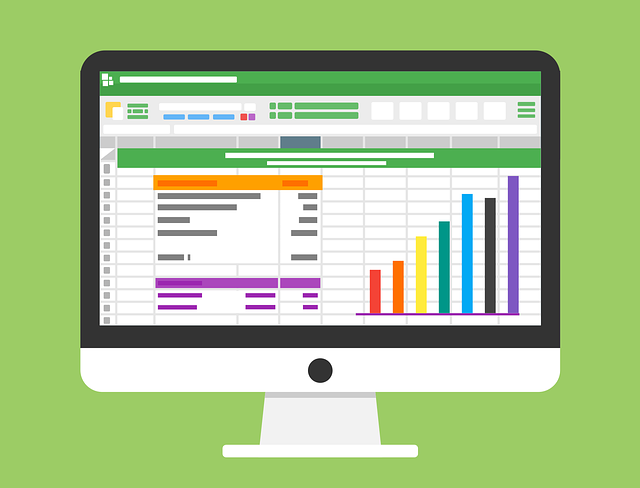In the world of marketing, two terms often come up: growth marketing vs demand generation. While they might seem like interchangeable terms, they actually have different focuses and strategies. Understanding the differences and similarities between growth marketing and demand generation is crucial for any marketer looking to effectively drive business growth.
While the end goal of both growth marketing and demand generation is to increase revenue and customer acquisition, the approaches they take and the metrics they use to measure success differ.
By understanding how they complement each other and applying the right strategies, marketers can unlock the full potential of their marketing efforts. So, let’s dive deeper into the differences and similarities between growth marketing and demand generation, and discover how they can work together to drive business success.
Here is the list of what I will talk about in this article:
Growth marketing vs demand generation: Detailed differences
Similarities between growth marketing and demand generation
Understanding the goals of growth marketing
Understanding the goals of demand generation
Strategies and tactics used in growth marketing
Growth marketing vs demand generation: How they work together
Conclusion: Growth marketing vs demand generation
Growth marketing vs demand generation: Detailed differences
Growth marketing
Growth marketing is all about implementing strategies that drive sustainable and scalable growth. It focuses on attracting, engaging, and retaining customers through various channels, such as content marketing, social media, SEO, and data analysis. The key difference between growth marketing and demand generation lies in their approach. Growth marketing focuses on the entire customer lifecycle, from acquisition to retention, while demand generation is more focused on creating awareness and generating leads.
In growth marketing, the goal is not just to acquire new customers but also to retain and maximize the value of existing customers. This requires a deep understanding of customer behavior, preferences, and needs. Growth marketers use data analysis to identify opportunities for optimization and improvement at every stage of the customer journey.
Demand generation
On the other hand, demand generation encompasses a broader range of activities aimed at creating awareness and interest in a product or service. It involves tactics like email marketing, search engine marketing, webinars, and events to generate demand and leads. The primary goal of demand generation is to create a pipeline of leads that can be nurtured and eventually converted into customers.

Similarities between growth marketing and demand generation
While growth marketing and demand generation have different focuses, they also share certain similarities. Both approaches aim to increase revenue and customer acquisition, although they may prioritize different stages of the customer journey. Both growth marketing and demand generation require a deep understanding of the target audience and their needs. They also rely on data analysis to measure the effectiveness of their strategies and make informed decisions.
Another similarity between growth marketing and demand generation is their reliance on various marketing channels and tactics. Both approaches utilize content marketing, social media, SEO, and other digital marketing techniques to reach their target audience. They both recognize the importance of delivering the right message to the right audience at the right time.
Understanding the goals of growth marketing
The primary goal of growth marketing is to drive sustainable and scalable growth. This involves attracting new customers, engaging them, and retaining them over the long term. Growth marketers focus on optimizing the entire customer lifecycle, from acquisition to retention, to maximize customer value.
To achieve these goals, growth marketers employ various strategies and tactics. They create compelling and valuable content that resonates with their target audience. They leverage social media platforms to engage with customers and build brand loyalty. They use SEO techniques to improve their website’s visibility in search engine results. They also analyze data to identify opportunities for optimization and improvement.
Understanding the goals of demand generation
Demand generation, on the other hand, is focused on creating awareness and generating leads. The primary goal of demand generation is to fill the top of the marketing funnel with potential customers. Marketers use various tactics, such as email marketing, search engine marketing, webinars, and events, to generate demand and capture leads.
The goal of demand generation is to create a pipeline of leads that can be nurtured and eventually converted into customers. Marketers use targeted messaging and personalized content to engage with leads and move them through the marketing funnel. They also rely on metrics like click-through rates, conversion rates, and cost per lead to measure the effectiveness of their demand generation efforts.
Strategies and tactics used in growth marketing
In growth marketing, the focus is on implementing strategies and tactics that drive sustainable and scalable growth. Growth marketers use a combination of inbound and outbound marketing techniques to attract, engage, and retain customers. Some of the strategies and tactics used in growth marketing include:
1. Content marketing: Creating valuable and relevant content that attracts and engages the target audience. This can include blog posts, videos, podcasts, and infographics.
2. Social media marketing: Leveraging social media platforms to engage with customers, build brand loyalty, and drive traffic to the website.
3. SEO: Optimizing the website to improve its visibility in search engine results and drive organic traffic.
4. Email marketing: Using email campaigns to nurture leads, build relationships with customers, and drive conversions.
5. Data analysis: Analyzing customer data to identify opportunities for optimization and improvement at every stage of the customer journey.
Strategies and tactics used in demand generation
Demand generation involves a broader range of activities aimed at creating awareness and generating leads. Marketers use various strategies and tactics to capture the attention of their target audience and generate demand. Some of the strategies and tactics used in demand generation include:
1. Email marketing: Sending targeted email campaigns to capture leads and nurture them through the marketing funnel.
2. Search engine marketing: Running paid search campaigns to increase visibility in search engine results and drive traffic to the website.
3. Webinars and events: Hosting webinars and events to educate and engage with the target audience, and generate leads.
4. Social media advertising: Running targeted ads on social media platforms to reach a wider audience and generate demand.
5. Content syndication: Partnering with other websites to distribute content and generate leads.
Growth marketing vs demand generation: How they work together
While growth marketing and demand generation have different focuses and strategies, they can work together to drive business success. Demand generation activities help fill the top of the marketing funnel with potential customers, while growth marketing strategies focus on converting those leads into customers and maximizing their lifetime value.
For example, a demand generation campaign may generate a large number of leads through webinars and events. Growth marketing strategies can then be employed to nurture those leads through personalized email campaigns, targeted content, and social media engagement. By aligning these two approaches, marketers can create a seamless customer journey that drives revenue growth and customer acquisition.
Conclusion: Growth marketing vs demand generation
In conclusion, growth marketing and demand generation are two distinct approaches that can work together to drive business success. While growth marketing focuses on sustainable and scalable growth, demand generation is more focused on creating awareness and generating leads. By understanding the differences and similarities between these two approaches, marketers can choose the right strategies and tactics to achieve their business goals.
Ultimately, the choice between growth marketing and demand generation depends on the unique needs and goals of your business. Some businesses may benefit from a more growth-oriented approach, while others may prioritize demand generation to fill their marketing funnel. By aligning these two approaches and leveraging the right strategies and tactics, marketers can unlock the full potential of their marketing efforts and drive business growth.
Did I cover everything about Growth marketing vs Demand Generation? Let me know in the comments below.
And before you go, check out this article about performance vs growth marketing.



